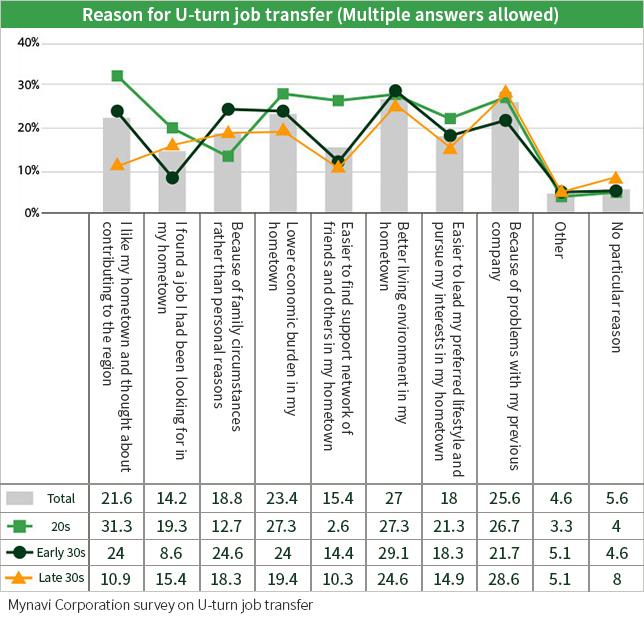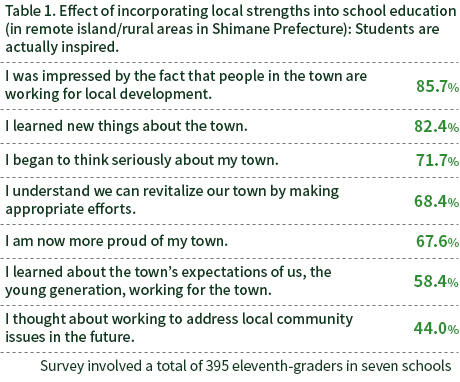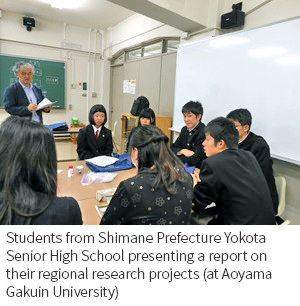As part of ongoing vigorous public discussions on regional revitalization issues, the media and local governments publish reports and suggestions seeking to draw attention to problems relating to the depopulation trend and declining community functions.
Many of these documents call for regional communities to overcome their dependence on attracting large businesses and public works, a previously popular regional revitalization measure. Looking for new approaches, regional communities should break away from the centralized social system and instead pursue a decentralized autonomous society (where each region pursues self-directed development efforts utilizing local resources and promoting local strengths).
In this context, I take note of recent trends indicating an increasing number of young people are considering leaving their present employer to find a new job in their hometown (U-turn job transfer). A relevant survey was conducted by Mynavi Corporation, collecting responses from Japanese men and women in their 20s and 30s who performed a U-turn job transfer. Regarding the reason for the U-turn job transfer, the most popular response among those in their 20s was “I like my hometown and thought about contributing to the region” (31.3%), which is followed by “lower economic burden in my hometown” (27.3%) and “better living environment in my hometown” (27.3%). Compared to older respondents, those in their 20s tend to feel closely attached to their hometown, and place a lot of weight on local connections with friends and associates.

Exploring approaches to regional development, I look at the trend of talented young people leaving urban life to return to their hometown, which can provide strong momentum. I believe that increasing young aspirations for creating jobs in hometown regions and innovating new projects to revitalize hometowns will become a driving force for achieving a decentralized autonomous society.
I have pursued a career in sociological research focusing on areas related to high school education. My recent activities center on field research to explore educational sociology themes for regional human resources development.
My present field research is based in remote island/rural areas in Shimane Prefecture. In these areas, some regional revitalization initiatives have begun to produce results, specifically through the Senior High School Revitalization Project, which aims to create attractive senior high schools by incorporating local strengths into education. Introducing specific reports on the project, I will discuss what roles senior high school education services can play in forming a decentralized autonomous society.
Oki-Dozen Senior High School (Oki-Dozen SHS) is located in the Dozen group of the Oki Islands (Dozen District), situated 60 km off the mainland coast of Shimane Prefecture. It is the district’s sole senior high school. Most of the graduates from the school move out of the district to attend university or gain employment in urban areas, a major factor for the district’s accelerating depopulation and demographic aging. The school suffered a sharp decline in new enrollments, recording a fall of more than half over a decade, from about 70 in 1998 to 28 in 2008, and thus faced the threat of consolidation.
The loss of the district’s only senior high school would have had a tremendous adverse impact on the local community. Those aged 15 to 18 would have to leave their home to attend senior high school outside of the district, imposing additional costs on the household for children living away from home, which would likely motivate the whole family to move away. Even worse, young families with children would be discouraged from returning to their hometown in Dozen District (U-turn) or newly moving to the district (I-turn). Given this situation, the local demographic aging issue would deteriorate virtually uncontrollably.
In 2008, facing up to the above-described threat, the Dozen District launched the Oki-Dozen Senior High School Revitalization Project. The project aims to create an attractive local senior high school that will be admired and desired by children and parents and also to arouse local residents’ interest in the school development, thereby developing inspiring and inspired human resources and a sustainable community.

According to the project plan, Oki-Dozen SHS ran the Special Advancement course and the Regional Development course. The latter offered various locally themed programs, such as an internship opportunity (on-site work experience activities in cooperation with local companies and organizations), regional studies aimed at developing the local workforce, project-based learning for improving comprehensive strengths, and practical sessions utilizing local human and non-human resources. In the 2015 school year, the school was designated by the Ministry of Education, Culture, Sports, Science and Technology as a Super Global High School for the plan to develop glocal capabilities in a remote island setting in order to pursue regional revitalization from a global viewpoint. To take the project to an even higher level, the course selection system was abolished to reorganize the entire school curriculum to include Glocal History and Community Life Science as required core subjects, starting from the new enrollment in the 2016 school year. The Glocal History class is designed to allow students to learn history both from regional and global perspectives. Community Life Science is an originally designed interdisciplinary subject to study approaches to achieving autonomy and collaboration in a regional community, with an eye to interconnection between the following four sets of elements: 1. school (learning) and society (practice); 2. subject-to-subject; 3. society (practice) and person (self); and 4. learning in school and life after graduation.
The project also produces a number of unique extracurricular programs. One representative example can be taken from the Hitotsunagi (literally “human networking”) club. The club produces a local short-stay program every year inviting high school students from across Japan and the Dozen District (about 10 each) to engage in various activities together. For another example, in the 2016 school year, the school started the annual Glocal Olympic event, inviting participation from senior high schools across the country.
Shimane Prefecture’s Senior High School Revitalization Project places greater importance on the teamwork process―teacher-to-student and student-to-student collaboration―for planning and organizing class activities, rather than on achieving preset targets. Out of the collaboration process come new improvement ideas and results, driving the school efforts (learning approaches) forward. Oki-Dozen SHS’s endeavor may still be evolving when this article reaches you.
Achievements from Oki-Dozen SHS’s efforts drew broad attention, contributing to an upturn in new enrollments from the 2012 school year, recording 45 in 2013 and 65 in 2015. About half of the students enrolled at present come from outside the Dozen District and are seeking an opportunity to pursue their socially aware interest in various areas related to regional revitalization and international contribution.
As a result of Oki-Dozen SHS’s success in creating an attractive senior high school, local young people have become aware of the possibility of satisfying their hidden desires to continue living and working in their hometown and contributing to the region. Additionally, the district is welcoming an increasing number of new families from outside, including those accompanying children entering Oki-Dozen SHS and those with younger children and a strong aspiration to enroll them in the school.
Inspired by the Dozen District’s success, the Shimane Prefectural government launched the senior high school revitalization/redevelopment project for remote island/rural areas, starting from fiscal year 2011. As a key policy, the project requires target schools to incorporate local strengths into education with the aim of using local resources to prepare learning materials and contributing to local development. Through this approach, the project seeks to achieve school revitalization and regional revitalization at the same time. The following are major areas selected for the dual purpose:
(1) Participation of municipalities and citizens
To proactively implement the policy of incorporating local strengths into education, the project includes schemes to allow relevant municipalities and citizens to provide personnel and financial support to target schools.
(2) Increasing students from outside the prefecture
The project includes a system to encourage inter-prefectural admission of applicants, seeking to bring in an adequate number of students from outside, with a view to preventing homegrown students from developing inappropriately inward-looking attitudes in association with the policy of incorporating local strengths into education, and to providing students at small rural schools with a closed culture with an opportunity to form new personal relationships.
(3) Career development programs beneficial to local industry
Students are provided with opportunities to participate in actual town development and product development projects, thereby fostering regional entrepreneurship. These career development programs are expected to be beneficial to the local industry in a number of ways, such as utilizing local resources to develop sixth industry projects, thereby helping promote an inflow of external funds and prevent the outflow of internal funds.
(4) Local authority and self-reliance
U-turn and I-turn job transferees are encouraged to participate in local events and discussions, and to bring new ideas and capabilities into the community. This is expected to help foster a community culture that inspires members to build a self-reliant attitude toward addressing local issues by discussing and proposing solutions with a sense of responsibility.
(5) Young, eccentric, outsiders
One essential key to successful regional revitalization initiatives is human resources. Particularly under this project, people are expected to play important roles by demonstrating their strengths in three categories. Those are specifically: energy and aspirations for the future (young people); outsider viewpoints and connections to external persons and organizations (people from outside); and capabilities to break through (eccentric people). The plan is to introduce outsider viewpoints and networks to schools and provide entrepreneurship training to develop breakthrough capabilities.
Many rural regions, even those with the potential for development, suffer from an obvious shortage of the human resources needed to realize it. One serious issue concerns the dwindling young population due to people moving away, often resulting in a dearth of new ideas. To tackle this challenge, it is essential to create an impetus to encourage young people to choose to move out of urban areas and live in rural towns.
In the past, when the population was increasing, urban areas faced various social problems related to their large or growing populations. Subsequently, the Japanese population peaked in 2008 and entered a downward phase. It is projected that the population will continue declining in the coming four decades or more, resulting in issues currently faced chiefly by underpopulated areas emerging throughout the country over the coming one or two decades. In light of this, in place of large cities, rural regions that have already built up a lot of experience in fighting issues of depopulation and a graying society will play a leading role in promoting community development in Japan, and more broadly around the world.
Previously, in the context of regional development, schools and education received relatively little attention. However, we should be more aware of the huge potential of education services as an instrument of regional development. More specifically, an appropriate education brand strategy can appeal to families with young children, thereby preventing the outflow and encouraging the inflow (U-turn and I-turn job transfers) of the relevant population group. The above-described successful project of Shimane Prefecture should provide a shining example for similar efforts that are or will be taking place across the country, offering useful insights to not only rural areas and regional cities but also to older districts in metropolitan areas.
For many regions in Japan that will sooner or later initiate similar actions to retain and increase the local young population, the key to success lies with senior high school development.

(This column is as of 2017.)